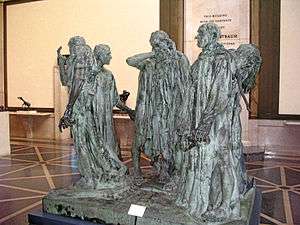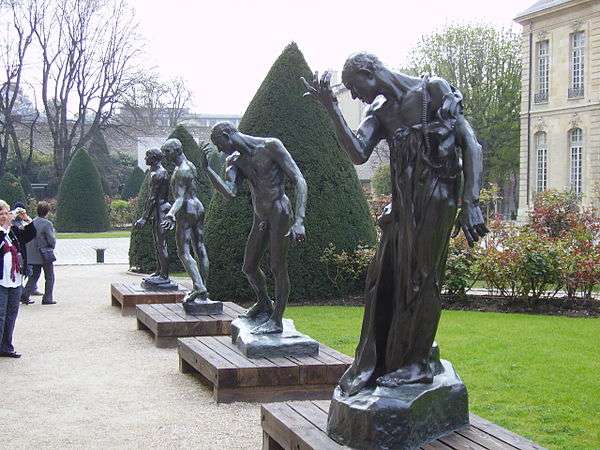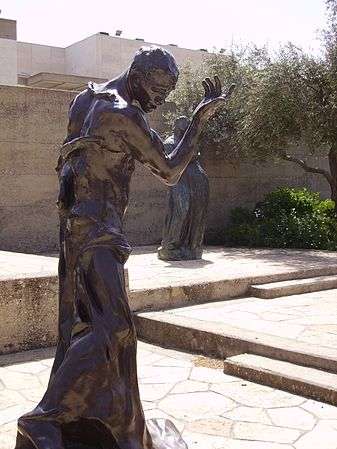The Burghers of Calais
.jpg) | |
| Artist | Auguste Rodin |
|---|---|
| Year | 1884–9 |
| Type | Bronze |
| Dimensions | 201.6 cm × 205.4 cm × 195.9 cm ( 79 3⁄8 in × 80 7⁄8 in × 77 1⁄8 in) |
| Location | Calais, France |
| 50°57′8.24″N 1°51′12.65″E / 50.9522889°N 1.8535139°E | |
Les Bourgeois de Calais is one of the most famous sculptures by Auguste Rodin. It commemorates an occurrence during the Hundred Years' War, when Calais, an important French port on the English Channel, was under siege by the English for over a year. Calais commissioned Rodin to create the sculpture in 1884, and the work was completed in 1889.[1]
History
England's Edward III, after a victory in the Battle of Crécy, laid siege to Calais, while Philip VI of France ordered the city to hold out at all costs. Philip failed to lift the siege, and starvation eventually forced the city to parley for surrender.
According to medieval writer Jean Froissart, Edward offered to spare the people of the city if six of its top leaders would surrender themselves to him, presumably to be executed. Edward demanded that they walk out wearing nooses around their necks, and carrying the keys to the city and castle. One of the wealthiest of the town leaders, Eustache de Saint Pierre, volunteered first, and five other burghers joined with him.[2] Saint Pierre led this envoy of volunteers to the city gates. It was this moment, and this poignant mix of defeat, heroic self-sacrifice, and willingness to face imminent death that Rodin captured in his sculpture, scaled somewhat larger than life.
Although the burghers expected to be executed, their lives were spared by the intervention of England's queen, Philippa of Hainault, who persuaded her husband to exercise mercy by claiming that their deaths would be a bad omen for her unborn child. (Her son, Thomas of Windsor, only lived for one year.)
Composition
The City of Calais had attempted to erect a statue of Eustache de Saint Pierre, eldest of the burghers, since 1845. Two prior artists were prevented from executing the sculpture: the first, David d'Angers, by his death; and the second, Auguste Clésinger, by the Franco-Prussian War. In 1884 the municipal corporation of the city invited several artists, Rodin amongst them, to submit proposals for the project.[3]
Rodin's design was controversial. The public had a lack of appreciation for it because it didn't have "overtly heroic antique references" which were considered integral to public sculpture.[4] It was not a pyramidal arrangement and contained no allegorical figures. It was intended to be placed at ground level, rather than on a pedestal. The burghers were not presented in a positive image of glory; instead, they display "pain, anguish and fatalism". To Rodin, this was nevertheless heroic, the heroism of self-sacrifice.[5]
In 1895 the monument was installed in Calais on a large pedestal in front of Parc Richelieu, a public park, contrary to the sculptor's wishes, who wanted contemporary townsfolk to "almost bump into" the figures and feel solidarity with them. Only later was his vision realized, when the sculpture was moved in front of the newly completed town hall of Calais, where it now rests on a much lower base.[6]
Casts

Under French law no more than twelve original casts of works of Rodin may be made.[8]
The first cast of the group of six figures, cast in 1895 still stands in Calais. Other original casts stand at:
- Glyptoteket in Copenhagen, cast 1903.
- the Royal Museum in Mariemont, Belgium, cast 1905.
- Victoria Tower Gardens in the shadow of the Houses of Parliament in London; cast 1908, installed on this site in 1914 and unveiled 19 July 1915. The inscription on the pedestal was carved by Eric Gill.[9]
- the Rodin Museum in Philadelphia, cast 1925 and installed in 1929.
- the gardens of the Musée Rodin in Paris, cast 1926 and given to the museum in 1955.
- Kunstmuseum in Basel, cast 1943 and installed in 1948.
- the Smithsonian Hirshhorn Museum and Sculpture Garden in Washington, D.C., cast 1943 and installed in 1966.
- the National Museum of Western Art in Tokyo, cast 1953 and installed in 1959.[10]
- the Norton Simon Museum in Pasadena, California, cast 1968.
- the Metropolitan Museum of Art in New York City, cast 1985 and installed in 1989.[11]
- PLATEAU (formerly the Rodin Gallery[12]) in Seoul.[13] This is the 12th and final cast in the edition, cast 1995.
Sculptures of the individual figures from the monument are on the campus of Stanford University.[14][15]
A study of Jean d'Aire stands in the Visual Arts Center at Davidson College. It was cast posthumously, in 1972.[16][17]
"The man with the key" figure is on the Sommerro park in Oslo, Norway
Gallery
|
References
- ↑ Linduff, David G. Wilkins, Bernard Schultz, Katheryn M. (1994). Art past, art present (2nd ed.). Englewood Cliffs, N.J.: Prentice Hall. p. 454. ISBN 0-13-062084-X.
- ↑ Froissart, Jean, Chronicles of England France, Spain, and the adjoining countries, (1805 translation by Thomas Jhones), Book I, ch. 145
- ↑ Jianou (1970), p.69.
- ↑ Linduff, David G. Wilkins, Bernard Schultz, Katheryn M. (1994). Art past, art present (2nd ed.). Englewood Cliffs, N.J.: Prentice Hall. p. 454. ISBN 0-13-062084-X.
- ↑ Elsen (1963), p. 72; Laurent (1989), p. 82.
- ↑ Laurent (1989), p. 89.
- ↑ "Burghers of Calais, (sculpture)". SIRIS
- ↑ Respecting Rodin's moral right. Le musée Rodin
- ↑ Hall, James (2003). "Auguste Rodin, The Burghers of Calais". In Verdi, Richard. Saved! 100 years of the National Art Collections Fund. Scala. pp. 128–133.
- ↑ "Burghers of Calais". The National Museum of Western Art. Retrieved January 27, 2012.
- ↑ "The Burghers of Calais". The Metropolitan Museum of Art. Retrieved 29 November 2012.
- ↑ About Plateau
- ↑ The Burghers of Calais, PLATEAU 2011. Retrieved 2012-01-11.
- ↑ 35 works by Rodin, 7 by his contemporaries, given to Stanford, Stanford University News Service (July 13, 1992)
- ↑ Rodin! The Complete Stanford Collection, Iris & B. Gerald Cantor Center for Visual Arts at Stanford University
- ↑ "Davidson College Art Galleries". Davidson College Art Galleries. Davidson College. Retrieved April 6, 2016.
- ↑ "Art on the Davidson College Campus". Auguste Rodin- Art on the Davidson College Campus. Davidson College Library. Retrieved April 6, 2007.
- ↑ "The Burghers of Calais, (sculpture)". SIRIS
Sources
- Elsen, Albert E. (1963). Rodin. New York: Museum of Modern Art.
- Jianou, Ionel (1970, transl. Kathleen Muston and Geoffrey Skelding). Rodin. Paris: ARTED.
- Laurent, Monique (1988, transl. 1989 by Emily Read). Rodin. New York: Konecky & Konecky. ISBN 1-56852-173-1.
Further reading
- Benedek, Nelly Silagy (2000). Rodin • The Burghers of Calais. New York: The Metropolitan Museum of Art. ISBN 0 87099 948 6.
- Chevillot, Catherine; Marraud, Hélène; Pinet, Hélène; Adamson, John (transl.) (November 2014). Rodin: The Laboratory of Creation. Dijon: Éditions Faton. ISBN 9782878442007.
- Le Normand-Romain, Antoinette (September 2014). Rodin. New York: Abbeville. ISBN 9780789212078.
External links
| Wikimedia Commons has media related to Les Bourgeois de Calais. |
- Interactive 3D imagery of The Burghers of Calais
- Link to The Burghers of Calais on the official website of the Musée Rodin.
- Rodin: The B. Gerald Cantor Collection, a full text exhibition catalog from The Metropolitan Museum of Art, which contains material on The Burghers of Calais.
- Cantor Collection educational pages on The Burghers of Calais with detailed illustrations.
- Link to account of the theft and recovery of The Burghers of Calais during WWII
- Williams College Magazine, Fall 2013.





